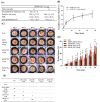Nanostructured Lipid Carrier Gel Formulation of Recombinant Human Thrombomodulin Improve Diabetic Wound Healing by Topical Administration
- PMID: 34575462
- PMCID: PMC8469737
- DOI: 10.3390/pharmaceutics13091386
Nanostructured Lipid Carrier Gel Formulation of Recombinant Human Thrombomodulin Improve Diabetic Wound Healing by Topical Administration
Abstract
Recombinant human thrombomodulin (rhTM), an angiogenesis factor, has been demonstrated to stimulate cell proliferation, keratinocyte migration and wound healing. The objective of this study was to develop nanostructured lipid carrier (NLC) formulations encapsulating rhTM for promoting chronic wound healing. RhTM-loaded NLCs were prepared and characterized. Encapsulation efficiency was more than 92%. The rate of rhTM release from different NLC formulations was influenced by their lipid compositions and was sustained for more than 72 h. Studies on diabetic mouse wound model suggested that rhTM-NLC 1.2 µg accelerated wound healing and was similar to recombinant human epidermal growth factor-NLC (rhEGF-NLC) 20 µg. By incorporating 0.085% carbopol (a highly crosslinked polyacrylic acid polymer) into rhTM NLC, the NLC-gel presented similar particle characteristics, and demonstrated physical stability, sustained release property and stability within 12 weeks. Both rhTM NLC and rhTM NLC-gel improved wound healing of diabetic mice and cell migration of human epidermal keratinocyte cell line (HaCaT) significantly. In comparison with rhTM solution, plasma concentrations of rhTM post applications of NLC and NLC-gel formulations were lower and more sustained in 24 h. The developed rhTM NLC and rhTM NLC-gel formulations are easy to prepare, stable and convenient to apply to the wound with reduced systemic exposure, which may warrant potential delivery systems for the care of chronic wound patients.
Keywords: angiogenesis factor; carbopol gel; chronic wound healing; nanostructured lipid carrier; protein drug delivery; sustained release; thrombomodulin.
Conflict of interest statement
The authors declare that there is no conflict of interest. The company had no role in the design of the study; in the collection, analyses, or interpretation of data; in the writing of the manuscript, or in the decision to publish the results.
Figures






Similar articles
-
Sustained release of recombinant thrombomodulin from cross-linked gelatin/hyaluronic acid hydrogels potentiate wound healing in diabetic mice.Eur J Pharm Biopharm. 2019 Feb;135:61-71. doi: 10.1016/j.ejpb.2018.12.007. Epub 2018 Dec 12. Eur J Pharm Biopharm. 2019. PMID: 30552972
-
The topical administration of rhEGF-loaded nanostructured lipid carriers (rhEGF-NLC) improves healing in a porcine full-thickness excisional wound model.J Control Release. 2015 Jan 10;197:41-7. doi: 10.1016/j.jconrel.2014.10.033. Epub 2014 Nov 6. J Control Release. 2015. PMID: 25449803
-
A novel strategy for the treatment of chronic wounds based on the topical administration of rhEGF-loaded lipid nanoparticles: In vitro bioactivity and in vivo effectiveness in healing-impaired db/db mice.J Control Release. 2014 Jul 10;185:51-61. doi: 10.1016/j.jconrel.2014.04.032. Epub 2014 Apr 29. J Control Release. 2014. PMID: 24794895
-
An EGF- and Curcumin-Co-Encapsulated Nanostructured Lipid Carrier Accelerates Chronic-Wound Healing in Diabetic Rats.Molecules. 2020 Oct 10;25(20):4610. doi: 10.3390/molecules25204610. Molecules. 2020. PMID: 33050393 Free PMC article.
-
Propolis-Based Nanostructured Lipid Carrier of α-Mangostin for Promoting Diabetic Wound Healing in Alloxan-Induced Mice.J Inflamm Res. 2025 Jun 9;18:7443-7457. doi: 10.2147/JIR.S525243. eCollection 2025. J Inflamm Res. 2025. PMID: 40519653 Free PMC article.
Cited by
-
Potential of the Nano-Encapsulation of Antioxidant Molecules in Wound Healing Applications: An Innovative Strategy to Enhance the Bio-Profile.Molecules. 2025 Jan 31;30(3):641. doi: 10.3390/molecules30030641. Molecules. 2025. PMID: 39942745 Free PMC article.
-
Combinational System of Lipid-Based Nanocarriers and Biodegradable Polymers for Wound Healing: An Updated Review.J Funct Biomater. 2023 Feb 18;14(2):115. doi: 10.3390/jfb14020115. J Funct Biomater. 2023. PMID: 36826914 Free PMC article. Review.
-
Recent Advances in Nano-Drug Delivery Systems for the Treatment of Diabetic Wound Healing.Int J Nanomedicine. 2023 Mar 27;18:1537-1560. doi: 10.2147/IJN.S395438. eCollection 2023. Int J Nanomedicine. 2023. PMID: 37007988 Free PMC article. Review.
-
Advancements and Challenges of Nanostructured Lipid Carriers for Wound Healing Applications.Int J Nanomedicine. 2024 Aug 15;19:8091-8113. doi: 10.2147/IJN.S478964. eCollection 2024. Int J Nanomedicine. 2024. PMID: 39161361 Free PMC article. Review.
-
Narrative review on nanoparticles based on current evidence: therapeutic agents for diabetic foot infection.Naunyn Schmiedebergs Arch Pharmacol. 2024 Sep;397(9):6275-6297. doi: 10.1007/s00210-024-03094-8. Epub 2024 Apr 19. Naunyn Schmiedebergs Arch Pharmacol. 2024. PMID: 38639898 Review.
References
Grants and funding
LinkOut - more resources
Full Text Sources

